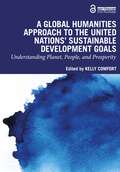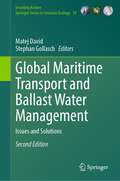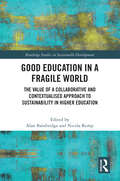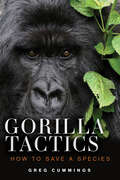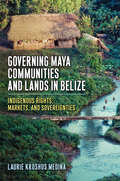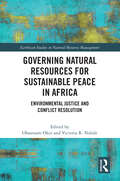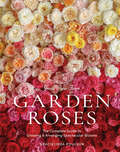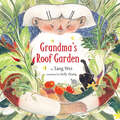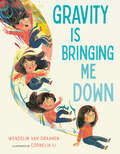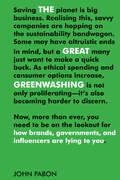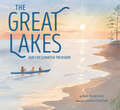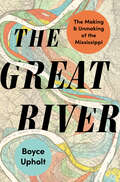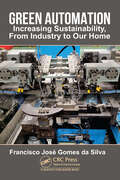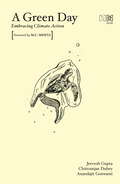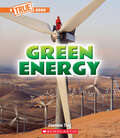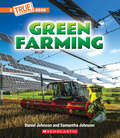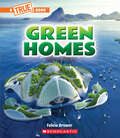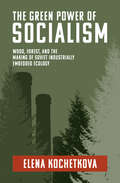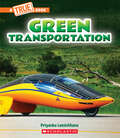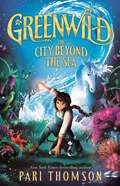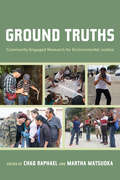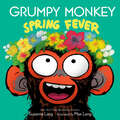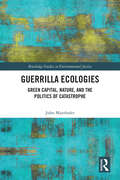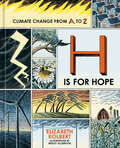- Table View
- List View
A Global Humanities Approach to the United Nations' Sustainable Development Goals: Understanding Planet, People, and Prosperity
by Kelly ComfortThis edited textbook explores the 17 UN SDGs through 12 works from the humanities, including films, novels, and photographic collections. It provides students with the knowledge and understanding of how the humanities engage in broader social, political, economic, and environmental dialogue, offering a global perspective that crosses national and continental borders. The book takes students through the UN SDGs from a theoretical perspective through to practical applications, first through specific global humanities examples and then through students’ own final projects and reflections. Centered around three major themes of planet, people, and prosperity, the textbook encourages students to explore and apply the Goals using a place-based, culturally rooted approach while simultaneously acknowledging and understanding their global importance. The text’s examples range from documentary and feature film to photography and literature, including Wang Jiuliang’s Plastic China, Kip Andersen and Keegan Kuhn’s Cowspiracy: The Sustainability Secret, Barbara Dombrowski’s Tropic Ice: Dialog Between Places Affected by Climate Change, and Aravind Adiga’s The White Tiger, among others. Providing diverse geographic and cultural perspectives, the works take readers to Argentina, Australia, China, Costa Rica, Ecuador, France, Greenland, Haiti, India, Japan, Peru, Rwanda, Senegal, and the United States. This broad textbook can be used by students and instructors at undergraduate and postgraduate levels from any subject background, particularly, but not exclusively, those in the humanities. With added discussion questions, research assignments, writing prompts, and creative project ideas, students will gain a nuanced understanding of the interconnectivity between social, cultural, ethical, political, economic, and environmental factors.
Global Maritime Transport and Ballast Water Management: Issues and Solutions (Invading Nature - Springer Series in Invasion Ecology #16)
by Matej David Stephan GollaschIn 2015 the first edition of this book was published before the Ballast Water Management (BWM) Convention entered into force. To our knowledge this was and still is the first comprehensive book on BWM worldwide. It provided an overview of possible solutions to the complex issue of BWM. It further outlined consequences and implications to address the ballast water "problem" in line with provisions of the BWM Convention considering environmental, shipping, legal and policy perspectives. The previously addressed subjects remain essential, but new subjects appeared which more recently have proven to be critical for the effective BWM Convention implementation. After the first book content was already agreed and in preparation, new advances were achieved in BWM-related research around the world. Further, new experience was gained and issues came out during the preparation processes of countries for the BWM Convention implementation. The editors of the first book remained heavily involved in BWM-related research and other processes, hence these new critical BWM issues and subjects are now dealt with in the second edition of this book to complement the first one. In essence, this new book covers main issues that arose recently during the implementation of the BWM Convention. Scientists and experts with extensive experience in these subjects from around the globe from academic and private sectors, as well as national administrations, were involved in the preparation of this book.
Good Education in a Fragile World: The Value of a Collaborative and Contextualised Approach to Sustainability in Higher Education (Routledge Studies in Sustainable Development)
by Alan Bainbridge Nicola KempThis edited collection aims to provoke discussion around the most important question for contemporary higher education – what kind of education (in terms of purpose, pedagogy and policy) is needed to restore the health and wellbeing of the planet and ourselves now and for generations to come? The book contains contributions from colleagues at a single UK University, internationally recognised for its approach to sustainability education. Introducing a conceptual framework called the ‘Paradox Model’, the book explores the tensions that underpin the challenge of developing sustainability in higher education in the 21st century. It asks probing questions about the purpose of higher education in the 21st century given growing concerns in relation to planetary safety and justice and calls for a rethinking of educational purpose. It draws upon the theory and practice of education and explores how these can develop an understanding of sustainability pedagogies in practice. Finally, it delivers thought-provoking discussion on what constitutes a ‘good’ higher education that meets the needs of a world in crisis. Drawing on a planetary health lens, the book concludes with a ‘manifesto’ that brings together the key insights from the contributing authors. This will be an engaging volume for academics and educators from a wide range of disciplines in higher educational settings interested in translating sustainability theory into educational practice.
Gorilla Tactics: How to Save a Species
by Greg CummingsGorillas are among the most recognizable of the large charismatic mammals, but climate change and poaching has brought them to the brink of extinction. Greg Cummings was the executive director of the Dian Fossey Gorilla Fund for seventeen years. He shares his fascinating experiences as a "wildlife Robin Hood"—raising money from the rich and famous and redistributing it to endangered gorillas and their habitats. He met and enlisted the help of celebrities such as Sigourney Weaver, Arthur C. Clark, Douglas Adams, and Leonardo DiCaprio. This thirty-year worldwide journey moves from boardrooms in Manhattan and London to mountain treks in Rwanda and Congo.Gorilla Tactics is sure to enchant readers with Greg's unique experiences, while sharing insight into the work it takes to save a species from extinction.
Governing Maya Communities and Lands in Belize: Indigenous Rights, Markets, and Sovereignties
by Laurie Kroshus MedinaConfronting a debt crisis, the Belizean government has strategized to maximize revenues from lands designated as state property, privatizing lands for cash crop production and granting concessions for timber and oil extraction. Meanwhile, conservation NGOs have lobbied to establish protected areas on these lands to address a global biodiversity crisis. They promoted ecotourism as a market-based mechanism to fund both conservation and debt repayment; ecotourism also became a mechanism for governing lands and people—even state actors themselves—through the market. Mopan and Q’eqchi’ Maya communities, dispossessed of lands and livelihoods through these efforts, pursued claims for Indigenous rights to their traditional lands through Inter-American and Belizean judicial systems. This book examines the interplay of conflicting forms of governance that emerged as these strategies intersected: state performances of sovereignty over lands and people, neoliberal rule through the market, and Indigenous rights-claiming, which challenged both market logics and practices of sovereignty.
Governing Natural Resources for Sustainable Peace in Africa: Environmental Justice and Conflict Resolution (Earthscan Studies in Natural Resource Management)
by Obasesam Okoi Victoria R. NaluleThis book examines the dynamics of natural resource conflicts in Africa and explores the different governance approaches for securing sustainable peace. One of the most prominent challenges facing Africa today is the consequences of natural resource extraction. While these resources hold the potential for economic transformation across Africa, their extraction also comes with a range of environmental, social, and economic consequences, including issues related to governance. This book assembles a unique cohort of peacebuilding, environmental justice, and sustainable development scholars and practitioners from Africa and beyond to examine the dynamics of natural resource conflict and explore the governance approaches that offer pathways for sustainable peace in Africa. Drawing on case studies and empirical lessons from the Horn of Africa, Southern Africa, West Africa, East Africa, and the Central Sahel region, along with the African Union, the multidisciplinary contributors offer fresh insights into the nature of natural resource conflict in Africa, delve deeper into the complexities of natural resource governance, and highlight the interplay between resource governance and sustainable peace. By shedding light not only on Africa’s experiences and vulnerabilities but also on the challenges of natural resource governance, this book fills a crucial gap in understanding the connection between natural resource governance, conflict, and pathways for sustainable peace in Africa. Drawing on a range of disciplinary perspectives, this book will be of interest to students and scholars of natural resource governance, peace and conflict studies, environmental policy and justice, sustainable development, security studies and African studies more widely.
Grace Rose Farm: The Complete Guide to Growing & Arranging Spectacular Blooms
by Gracielinda PoulsonAn inspiration of roses A one-of-a-kind guide to growing, cutting, and arranging the most beautiful roses in the world, Garden Roses belongs in the hands of every flower lover. Created by Gracielinda Poulson, the preeminent rose grower in the country and proprietor of Grace Rose Farm, each page of this glorious book steeps the reader in the iconic mystique of the rose: Its breathtaking beauty, in hundreds of photographs. Its secrets, in the incredible breadth of information on the varieties best suited for cutting and how to raise them to thrive in the garden or a container, in almost any climate zone. And its unique presence in our lives, in all the ways to style and display roses, from a simple vaseful to more elaborate tablescapes and floral arches, truly elevating the flower that more than any other has captured our imaginations and delighted our eyes.
Grandma's Roof Garden
by Tang WeiGranny may be old, but she’s certainly not feeble – or idle! She’s built a splendid vegetable garden from scratch on the rooftop of her Chengdu apartment building.She collects thrown-away produce and feeds it to her chicks and geese – or composts it for the garden. She waters, weeds, and teaches the neighborhood children to care for the garden like she does: with love, patience, and pride. And come harvest time, Granny gathers her fresh produce and cooks up delicious meals for her friends and family…or gives them their own bags of yummy treasures so they can cook on their own!Debut author/illustrator Tang Wei creates a love letter to an indomitable grandma of the city, inspired by her own childhood and a beloved relative. In rhyming couplets and quatrains reminiscent of Chinese nursery rhymes and folk chants, and vibrant colored pencil drawings, Wei shows how one person can create a beautiful green space in the heart of the concrete jungle, bringing together an entire community.
Gravity Is Bringing Me Down
by Wendelin Van DraanenGravity becomes a very personal problem for a girl as she stumbles and tumbles through a long day. A hilarious look at a core science concept for any kid who has ever had a case of the clumsies!When Leda wakes up by falling out of bed, she knows that gravity is in a very bad mood. Again.Sure enough, she struggles with stumbles and bumbles at home, trips and blips on the bus, and bashes and crashes in the classroom. But a lesson on gravity helps her understand what&’s really going on. And after a visit to a science center, Leda's mood is lifted...just in time for her to tumble-- happily!--into bed.With a very funny text from award-winner Wendelin Van Draanen and bright, bouncy illustrations from Cornelia Lia, Gravity is Bringing Me Down makes it hilariously clear how this science concept impacts kids' lives every day.
The Great Family of Life: Rethinking the place of Homo sapiens in the Biosphere
by David Rodríguez-RodríguezThis book explains the causes, consequences and desirable solutions to the unbalanced and unfair relationship between Homo sapiens and the other species that inhabit Planet Earth in a succinct, enjoyable and thought-provoking way. Major sociological, economic, political, educational, religious and phylosophical perspectives are reviewed in order to understand why we have reached the current alarming status of global biodiversity during the Anthropocene, and how we can react to it to attain not just human welfare, but global happiness. The target audience is wide, from the general public interested in the deep inner causes of environmental degradation, to college and university students and lecturers, notably in the fields of environmental ethics, environmental philosophy, environmental law and environmental politics.
The Great Greenwashing: How Brands, Governments, and Influencers Are Lying to You
by John PabonSaving the planet is big business. Realising this, savvy companies are hopping on the sustainability bandwagon. Some may have altruistic ends in mind, but most want to make a quick buck. As ethical spending and consumer options increase, greenwashing is not only proliferating—it’s becoming harder to discern. But how is someone at the supermarket supposed to decipher all this? In The Great Greenwashing, John Pabon pulls no punches in arming consumers and business professionals with the tools they need to educate themselves, filter out the nonsense from the truth, and make a positive impact.
The Great Lakes: Our Freshwater Treasure
by Barb RosenstockA stunning picture book about the five largest lakes in North America - how they formed, the importance of their abundant freshwater, and how they've become a national treasure - in the latest book from the author of Caldecott Honor book The Noisy Paint Box.The Great Lakes—Huron, Ontario, Michigan, Erie, and Superior—are five blue jewels set a bit off center in a belt across North America&’s middle. Bordered by eight states and part of Canada, the Lakes hold 21% of the world's fresh water. How did these incredible lakes get there? And what can we do to preserve such a treasure?Follow along as a drop of water in this enormous system and uncover its dramatic journey from lake to rive to lake, over Niagara Falls to lake and river again, and finally into the Atlantic Ocean.
The Great River: The Making and Unmaking of the Mississippi
by Boyce UpholtA sweeping history of the Mississippi River—and the centuries of human meddling that have transformed both it and America. The Mississippi River lies at the heart of America, an undeniable life force that is intertwined with the nation’s culture and history. Its watershed spans almost half the country, Mark Twain’s travels on the river inspired our first national literature, and jazz and blues were born in its floodplains and carried upstream. In this landmark work of natural history, Boyce Upholt tells the epic story of this wild and unruly river, and the centuries of efforts to control it. Over thousands of years, the Mississippi watershed was home to millions of Indigenous people who regarded “the great river” with awe and respect, adorning its banks with astonishing spiritual earthworks. The river was ever-changing, and Indigenous tribes embraced and even depended on its regular flooding. But the expanse of the watershed and the rich soils of its floodplain lured European settlers and American pioneers, who had a different vision: the river was a foe to conquer. Centuries of human attempts to own, contain, and rework the Mississippi River, from Thomas Jefferson’s expansionist land hunger through today’s era of environmental concern, have now transformed its landscape. Upholt reveals how an ambitious and sometimes contentious program of engineering—government-built levees, jetties, dikes, and dams—has not only damaged once-vibrant ecosystems but may not work much longer. Carrying readers along the river’s last remaining backchannels, he explores how scientists are now hoping to restore what has been lost. Rich and powerful, The Great River delivers a startling account of what happens when we try to fight against nature instead of acknowledging and embracing its power—a lesson that is all too relevant in our rapidly changing world.
Green Automation: Increasing Sustainability, From Industry to Our Home
by Francisco José Gomes da SilvaEnvironmental issues are a growing concern for our society, and should deserve increased attention, given the extremely negative climate changes which have been taking place. Emissions of greenhouse gases, excessive dependence on fossil fuels, growing consumption of power energy, and exacerbated consumption of materials are some of the problems that need to be addressed urgently. Some of these problems can be overcome through ingenious solutions based on automation. This book aims to make a contribution precisely in this sense, criticizing the current state of society in general and providing some solutions that can be used as a basis for the development of more environmentally friendly systems.
A Green Day: Embracing Climate Action
by Jeevesh Gupta Chittranjan Dubey Anandajit GoswamiAn Engaging Compilation of Perspectives on Climate Activism The impassioned essays, noteworthy profiles and first-person narratives in this anthology champion grassroots and global environmental movements that have persuaded policymakers and mobilized communities to take note of the worsening state of the natural order. From the Global South to the Global North, change advocates and those experiencing the thick of the emergency revisit the tipping points in their activism journey, lay out harsh truths about the extent of damage caused and offer scalable solutions to combat the mounting crisis. Outlining their rage, despair, fears and hope for the future, the campaigners underscore that there may be reasons to be optimistic despite the dreary reality we find ourselves in. While calling for collective action, these wide-ranging, inspiring and urgent stories reflect a diverse landscape of climate activism and are enough evidence that a sea change is possible.
Green Energy (A True Book (Relaunch))
by Jasmine TingEnvision a brighter future with this STEM-based subset of True Books.We use a lot of energy to power our lives = from our homes and cars to our tablets and handheld games. The challenge facing us today is finding sustainable energy methods that will ensure a green future. There are seven different types of green energy = and they are the only types that don't pollute our Earth. We have learned how to harness the power of the sun, wind, water, and Earth. And technological innovations have allowed us to put these alternative energies to work in our everyday lives. Green Energy will show you how.ABOUT THE SERIES:What would a green future look like? Will trains and airplanes be powered by the sun? Will we have homes that have zero impact on the environment? The most pressing challenge facing us today is how to ensure a healthy Earth for ourselves and future generations. This STEM-based set of A True Books introduces students to the engineering innovations that can help us reach those goals. Interesting information is presented in a fun, friendly way = and in the simplest terms possible = and will inspire kids to start envisioning and enacting a more sustainable future.
Green Farming (A True Book (Relaunch))
by Daniel Johnson Priyanka LamichhaneEnvision a brighter future with this STEM-based subset of True Books.Thanks to the development of agriculture, our Earth can feed the almost 8 billion people that call it home. But the challenge facing us today is how to make the practice of large-scale farming sustainable. We have learned how to use alternative energies = like solar and wind power = to run our farms. We have also learned how to use the land and the animals on it in a more environmentally friendly way. Green Farming will show you how.ABOUT THE SERIES:What would a green future look like? Will trains and airplanes be powered by the sun? Will we have homes that have zero impact on the environment? The most pressing challenge facing us today is how to ensure a healthy Earth for ourselves and future generations. This STEM-based set of A True Books introduces students to the engineering innovations that can help us reach those goals. Interesting information is presented in a fun, friendly way = and in the simplest terms possible = and will inspire kids to start envisioning and enacting a more sustainable future.
Green Homes (A True Book (Relaunch))
by Felicia BrowerEnvision a brighter future with this STEM-based subset of True Books.Small changes over the years = from smarter light bulbs to energy-efficient appliances = have made our homes more environmentally friendly. In recent years we have learned how to make alternative energies and Earth-friendly building methods and materials a reality. Today we understand how to build green homes = dwellings that have zero negative impact on the environment. Green Homes will show you how.ABOUT THE SERIES:What would a green future look like? Will trains and airplanes be powered by the sun? Will we have homes that have zero impact on the environment? The most pressing challenge facing us today is how to ensure a healthy Earth for ourselves and future generations. This STEM-based set of A True Books introduces students to the engineering innovations that can help us reach those goals. Interesting information is presented in a fun, friendly way = and in the simplest terms possible = and will inspire kids to start envisioning and enacting a more sustainable future.
The Green Power of Socialism: Wood, Forest, and the Making of Soviet Industrially Embedded Ecology (History for a Sustainable Future)
by Elena KochetkovaHow the Soviet forestry industry developed a unique form of industrial ecology—a commonsense approach toward natural resources for the economy and society.In The Green Power of Socialism, Elena Kochetkova examines the relationship between nature and humans under state socialism by looking at the industrial role of Soviet forests. The book explores evolving Soviet policies of wood consumption, discussing how professionals working in the forestry industry of the Soviet state viewed the present and future of forests by considering them both a natural resource and a trove of industrial material. When faced with the prospect of wood shortages, these specialists came to develop new industry-ecology paradigms. Kochetkova looks at the materiality of Soviet industry through forests and wood to show how, paradoxically, industrial ecology emerged and developed as a by-product of the Soviet industrialization project.The Green Power of Socialism also discusses how post-Soviet industry has abandoned these socialist practices and the idea of nature as a complicated ecosystem that provides a crucial service to society. Emphasizing the technological and environmental impacts of the Cold War, Kochetkova critically reconsiders two explanatory models that have become dominant in the historiography of Soviet approaches to nature over the last decades—ecocide and environmentalism. Within the context of the current environmental crisis, the book invites readers to reevaluate state socialism as a complex phenomenon with sophisticated interactions between nature and industry. In so doing, it contributes a fresh perspective on the activities of socialist experts and their view of nature, shedding light on Soviet state industrial and environmental policy and its continuing legacy in the present day.
Green Transportation (A True Book (Relaunch))
by Priyanka LamichhaneEnvision a brighter future with this STEM-based subset of True Books.Electric cars. Solar-powered planes. Poop-fueled trucks. Each of these technological advances in transportation is bringing us ever closer to a green future, and more are being developed all the time. Considering how many vehicles are on our roads = and in the water and air = sustainable transportation might be the most important innovation we can make to ensure our planet's future. Learn how in Green Transportation.ABOUT THE SERIES:What would a green future look like? Will trains and airplanes be powered by the sun? Will we have homes that have zero impact on the environment? The most pressing challenge facing us today is how to ensure a healthy Earth for ourselves and future generations. This STEM-based set of A True Books introduces students to the engineering innovations that can help us reach those goals. Interesting information is presented in a fun, friendly way = and in the simplest terms possible = and will inspire kids to start envisioning and enacting a more sustainable future.
Greenwild: The World Behind The Door (Greenwild #2)
by Pari ThomsonDaisy Thistledown’s epic adventure continues in the spellbinding sequel to the New York Times bestseller Greenwild, which A.F. Steadman (bestselling author of Skandar and the Unicorn Thief) praised as "Phenomenal . . . If you don’t believe in magic, you will after you’ve read Greenwild."In a land ruled by water, treachery runs deep, and Daisy Thistledown’s journey is just beginning...Desperate to join the expedition searching for her mother and the other missing Botanists, Daisy and her friends abandon the safety of magical Mallowmarsh. Facing danger on the high seas, they find themselves pursued across the waves by ruthless Grim Reapers. But they will need help to defeat these dangerous enemies. Their greatest hope: to find the legendary Iffenwild, a mysterious city hidden beyond the sea and lost to time.New discoveries await, and a strange botanical magic stirs beneath the waves. It will take all of Daisy’s courage and determination—and the trust of an unexpected new friend—if she is to save the Greenwild from a terrible fate.Don't miss out on this exciting trilogy!• Book 1 - Greenwild: The World Behind the Door• Book 2 - Greenwild: The City Beyond the Sea• Book 3 - Coming soon!
Ground Truths: Community-Engaged Research for Environmental Justice
by Chad Raphael and Martha MatsuokaA free ebook version of this title is available through Luminos, University of California Press’s Open Access publishing program. Visit www.luminosoa.org to learn more. This is the first book devoted entirely to summarizing the body of community-engaged research on environmental justice, how we can conduct more of it, and how we can do it better. It shows how community-engaged research makes unique contributions to environmental justice for Black, Indigenous, people of color, and low-income communities by centering local knowledge, building truth from the ground up, producing actionable data that can influence decisions, and transforming researchers’ relationships to communities for equity and mutual benefit. The book offers a critical synthesis of relevant research in many fields, outlines the main steps in conducting community-engaged research, evaluates the major research methods used, suggests new directions, and addresses overcoming institutional barriers to scholarship in academia. The coauthors employ an original framework that shows how community-engaged research and environmental justice align, which links research on the many topics treated in the chapters—from public health, urban planning, and conservation to law and policy, community economic development, and food justice and sovereignty.
Grumpy Monkey Spring Fever (Grumpy Monkey)
by Suzanne LangEveryone’s favorite grump, Jim Panzee, star of the bestselling Grumpy Monkey series, has caught a bad case of spring fever and wakes up feeling very silly in this delightful new picture book. <p><p> When Jim runs through the jungle laughing and shouting with glee, the other animals are very concerned. This just isn’t the grumpy Jim they know. Soon Norman diagnoses Jim with a bad case of spring fever and tells Jim that he needs to find a cure. The other jungle animals offer suggestions: Take a calming breath! Sniff lavender! Take a nap! Try a time-out! Jim tries everything to get his grump back, but when nothing works, it becomes contagious and the other animals catch spring fever too. Soon the jungle erupts into a silly celebration of springtime as they all join in the fun. <p><p> From the bestselling team Suzanne and Max Lang comes another fun filled adventure starring the beloved chaacter Jim Panzee. Lively illustrations offering a belly laugh on every spread will delight the many Grumpy Monkey fans. <p> <b>New York Times Bestseller</b>
Guerrilla Ecologies: Green Capital, Nature, and the Politics of Catastrophe (Routledge Studies in Environmental Justice)
by John MaerhoferThis book intervenes in contemporary debates about climate activism, militancy, and strategy that have been gathering force in radical ecological circles. It responds to some of the urgent questions about utilizing militancy as part of the overall effort to foster an ecosocialist society. Building upon the crucial work of scholars and activists from the 1970s to the present, such as Carolyn Merchant, Ursula Heise, Raj Patel, Joan Martinez Alier, Neil Smith, and Mark Dowie, this book discusses and regenerates key principles of guerrilla ecology. It presents a significant critique of green capital and its impact on the shape of environmental and climate justice movements. From car manufacturers dedicating profits to reforestation, to big oil conglomerates funneling money into universities that are developing techno-fixes which may stave off ecological disaster, green capital has become the mainstay of contemporary cultural, political, and economic reproduction – aiming to fuse profitability and sustainability. The book brings together discussion on key topics in a range of contexts including biopiracy and biocolonialism, indigenous resistance, extractivism, anti-imperialism, ecotage, and eco-militancy. It will attract scholarly readers from diverse spaces in the environmental humanities, environmental and climate justice, radical ecology, and philosophy.
H Is for Hope: Climate Change from A to Z
by Elizabeth KolbertIn twenty-six essays—one for each letter of the alphabet—the Pulitzer Prize-winning author of The Sixth Extinction takes us on a hauntingly illustrated journey through the history of climate change and the uncertainties of our future.Climate change resists narrative—and yet some account of what&’s happening is needed. Millions of lives are at stake, and upward of a million species. And there are decisions to be made, even though it&’s unclear who, exactly, will make them.In H Is for Hope, Elizabeth Kolbert investigates the landscape of climate change—from &“A&”, for Svante Arrhenius, who created the world&’s first climate model in 1894, to &“Z&”, for the Colorado River Basin, ground zero for climate change in the United States. Along the way she looks at Greta Thunburg&’s &“blah blah blah&” speech (&“B&”), learns to fly an all-electric plane (&“E&”), experiments with the effects of extreme temperatures on the human body (&“T&”), and struggles with the deep uncertainty of the future of climate change (&“U&”).Adapted from essays originally published in The New Yorker and beautifully illustrated by Wesley Allsbrook, H Is for Hope is simultaneously inspiring, alarming, and darkly humorous—a unique examination of our changing world.
